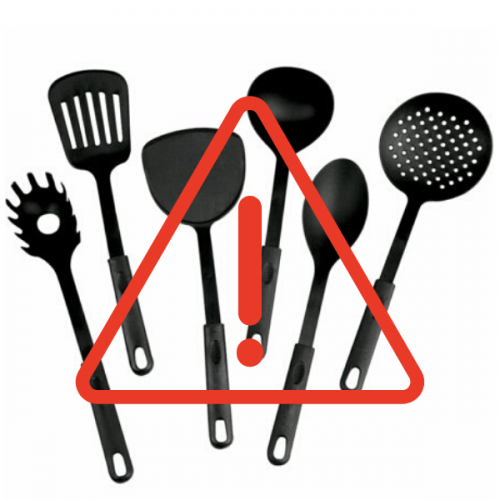Why Black Plastic Is Bad News
Black plastics are more likely to contain unregulated amounts of toxic chemicals including heavy metals and flame retardants which can leach into food and pose a hazard to human health. In addition, black plastics are not recyclable due to their color.
The black color is created by adding a substance called carbon black to the plastic. Carbon black which contains numerous compounds, some of which like polycyclic aromatic hydrocarbons (PAHs) have carcinogenic properties that have lead the International Agency for Research on Cancer (IARC) to classify carbon black as “possibly carcinogenic to humans.” It is not yet known if carbon black leaches out of black plastic containers into food during microwaving but we would not recommend microwaving food in any color of plastic container (see our fact sheet on microwaving plastics for more details.)
Although black plastic makes up 15% of all plastic recyclables (largely single-use food containers), the vast majority is not recycled because the technology used by recycling facilities to sort plastics cannot “see” the color black. These materials reclamation facilities (known as MRFs for short) use an infrared light (known as Near Infrared or NIR for short) to sort the plastics by color and as carbon black absorbs infrared light, the facility simply does not register black plastics and they do not get sorted for recycling. As a result of this failure, most black plastic items end up in our landfills, incinerators, or littered in our environment after just a single use.
Due to the lack of recycled black plastic, the demand is often met with e-waste (discarded electronics like old computers, phones, TVs, monitors, speakers, and appliances) that contains toxic chemicals such as phthalates, flame retardants, and heavy metals such as cadmium, lead, nickel, chromium, and mercury.
These chemical-laced plastics are melted down, mixed with food grade plastics and turned into children’s toys, single-use utensils and coffee stirrers, hot cup lids, cooking implements, insulated mugs, jewelry, garden hoses, and holiday decorations, among other items.
Although existing safety regulations limit the amounts of these chemicals and metals present in electronics, there are currently NO government regulations covering the safety of recycled black plastic items. Therefore, high levels of toxic chemicals that are prohibited in your laptop or phone are perfectly legal in your black plastic fork, spatula, slotted spoon, or hot cup lid.
A 2018 University of Plymouth study found toxic chemicals present at up to 30 times the levels considered safe in a full 40 percent of the black plastic toys, thermoses, cocktail stirrers, and utensils tested.
A 2024 study conducted by scientists from Toxic Free Future and Vrije Universiteit Amsterdam published in Chemosphere found high levels of cancer-causing, hormone-disrupting flame retardant chemicals in a variety of household products made with black plastics including food serviceware, kitchen utensils, and toys.
Even at very low levels, these toxic chemicals can cause serious reproductive and developmental problems, poisoning the brain and kidneys, disrupting human thyroid function, affecting development, and causing long-term neurological damage.
Items of the greatest concern include black plastic cooking utensils, stirrers, food containers, and hot cup lids, as exposure to heat increases the likelihood of these toxic chemicals leaching into your food and drink. Children’s toys are another area of great concern due to the high likelihood that they will be chewed or sucked on.
WHAT SHOULD YOU DO?
Get rid of any plastic cooking utensils in your kitchen. Stick to wood or stainless steel.
Avoid microwaving food in black plastic (and in all plastics).
If you purchase food in a black plastic container, switch it to a glass, ceramic or metal storage container when you get it home.
Carry your own metal or bamboo cutlery and straw so that you’ll never need to take a black plastic fork, spoon, knife, stirrer or straw again.
Avoid single-use hot cups, particularly those with black plastic sippy lids. Bring your own metal or ceramic mug, instead (and make sure the top is not made of black plastic!)
NEWS
Black plastic items could contain harmful chemicals, study finds | CBS | 10/11/2024
Black Plastic Items Can Have Cancer-Causing BFRs, New Study Warns | Forbes | 10/9/2024
Black-colored plastic used for kitchen utensils and toys linked to banned toxic flame retardants | CNN | 10/1/2024
SCHOLARLY ARTICLES
"From e-waste to living space: Flame retardants contaminating household items add to concern about plastic recycling." Megan Liu et al. Chemosphere, Volume 365, October 2024. https://doi.org/10.1016/j.chemosphere.2024.143319
"Black plastics: Linear and circular economies, hazardous additives and marine pollution." Andrew Turner. Environment International, Volume 117, August 2018.
MORE RESOURCES
• "The Dark Side of Black Plastics." Joe Schwarcz, PhD, McGill University Office for Science and Society. Aug. 17, 2023
• "Black plastic: what’s the problem?" Alice Hunter, Greenpeace UK, November 23, 2018.
• "Black plastic - can it be recycled?" RecycleNow (UK)
• "Why is black plastic packaging so hard to recycle?" World Economic Forum





